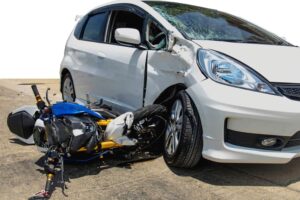You see that rider ahead, and you want to get by. Easy, right? Well, not always. There’s a way to do it that doesn’t involve turning someone’s leisurely ride into a roadside nightmare, and then there’s… well, the other way.
If you’re behind the wheel of a car or truck, you’re piloting a multi-ton machine. Motorcycles, on the other hand, are exposed, agile, and far more vulnerable. So, treating a pass like it’s just another Tuesday commute isn’t going to cut it.
If someone else’s negligence has caused your motorcycle accident while they tried to pass you, don’t let the insurance companies dictate your compensation. Reach our a experienced motorcycle accident lawyer near your.
Call Cook, Barkett, Ponder & Wolz today at (573) 335-6651 for a free consultation.
Why Passing Motorcycles Requires Extra Caution
According to the National Highway Traffic Safety Administration (NHTSA), motorcyclists are vastly overrepresented in traffic fatalities. In one recent year, per vehicle mile traveled, motorcyclists were about 24 times more likely than passenger car occupants to die in a traffic crash.
Wobbles, Weaves, and Wind
Motorcycles don’t always travel in a perfectly straight line within their lane. Riders often adjust their position for a variety of reasons: to avoid road debris, to get a better view, to avoid oil slicks, or simply to be more visible. What might look like erratic movement to you is often a deliberate and necessary maneuver for the rider.
Wind is another big player here. A strong crosswind pushes a motorcycle significantly. The blast of air coming off a large truck or even a fast-moving car has a similar effect, especially when passing. If you’re too close, you might actually contribute to the instability you’re trying to avoid.
They might also need to swerve suddenly to avoid hazards you haven’t even registered. That pebble on the road? Annoying for your tire, potentially a serious problem for a motorcycle.
Blind Spots
You’ve got blind spots. We all do. But motorcycles, due to their slim profile, disappear into them with alarming ease. That rider you saw a second ago? Double-check. Triple-check. They are often hidden by your car’s A-pillars, C-pillars, or even by a dirty spot on your window if you’re not diligent.
Your blind spots are not the only concern; the rider also has to contend with visibility. Their mirrors are smaller, and they don’t have the same panoramic view you might. They might not see you signaling your intention to pass if you’re tailgating them or approaching too quickly from an unexpected angle.
This is where patience and deliberate action become your best friends. Assuming a motorcycle sees you or will behave predictably is a recipe for trouble. Always confirm, always give space.
The Guide to Passing a Motorcycle Safely
Step 1: The Scan – More Than Just a Glance
Before you even think about moving your steering wheel an inch, you need to know what’s happening around you.
- Forward: Is the road clear ahead? Are there intersections, merging traffic, or anything that might cause the motorcycle (or you) to suddenly slow down? Is the passing zone long enough?
- Rearview Mirror: Anyone coming up fast behind you who might get antsy?
- Side Mirrors and Blind Spots: This is huge. Check, double-check, and then check again for the motorcycle. If you have passengers, even ask them to confirm if you’re unsure. Remember how easily they can hide.
You’re looking for a clear, safe window. If there’s any doubt, any doubt at all, just wait. A few seconds of patience beats years of regret.
Step 2: Signal Like You Mean It (Because You Do)
Signal early. Give the motorcyclist ample warning that you’re planning to move into the adjacent lane. This allows them to adjust their position or speed if necessary and, more importantly, lets them know you’ve actually seen them.
Don’t just flick it on as you’re already turning the wheel. Signal for a good three to five seconds before you begin the maneuver. This communicates respect and awareness, and it gives everyone involved time to process what’s about to happen.
Step 3: The Full Lane Commitment – No Squeezing By
This is where many drivers get it catastrophically wrong. When you pass a motorcycle, you must give them the entirety of their lane. Do not, under any circumstances, try to squeeze by in the same lane. It doesn’t matter if there “looks like enough room.” There isn’t.
Move completely into the adjacent lane to pass. Think of the motorcycle as occupying the full width of their lane, just like a car would. This provides a crucial safety buffer. Motorcyclists are entitled to the full use of their lane, and attempting to share it during a pass is not only dangerous but also illegal in many places.
Maintain your speed or accelerate gently as you pass. Avoid aggressive acceleration that might startle the rider or create unnecessary wind buffeting.
Step 4: The Gentle Return – Don’t Cut ‘Em Off
Once you’ve passed the motorcycle, don’t immediately swerve back into their lane. This is just as dangerous as not giving them enough space during the pass. You need to see the entire motorcycle in your rearview mirror before you even consider moving back over. Some people say wait until you see their headlight, but seeing the whole bike is a safer bet.
When you do return to the lane, do it smoothly and maintain your speed. Don’t slow down right after passing. This forces the rider to brake, which can be annoying at best and dangerous at worst. Give them the same courtesy you’d expect from someone passing you.
Special Situations: Two-Lane Roads and Group Rides
Passing on a two-lane road (one lane in each direction) requires even more caution. Ensure you have a very long, clear stretch of road with no oncoming traffic. Misjudging the speed and distance of an oncoming car when a motorcycle is involved leads to potentially fatal consequences for the rider squeezed in the middle.
If you encounter a group of motorcyclists, they will often ride in a staggered formation. Don’t assume you can just pick them off one by one by weaving in and out of their formation. It’s generally safer to pass the entire group in one go, as if they were a single long vehicle, ensuring you have ample space and time to do so. If the group is very long, you might need to pass them in smaller sub-groups, always returning to your lane with proper clearance before attempting to pass the next set.
Patience is paramount in these scenarios. If it’s not clearly safe, just hang back. It’s not a race.
What the Law Says About How to Safely Pass a Motorcycle (Missouri Focus)
General Passing Rules – The Foundation
Let’s start with the basics. Missouri Revised Statute 304.016 lays out the general rules for passing other vehicles. A key takeaway is that the driver of an overtaking vehicle (that’s you, in this scenario) must pass to the left of the overtaken vehicle at a safe distance and shall not again drive to the right side of the roadway until safely clear of the overtaken vehicle.
What’s a “safe distance”? While the statute might not give you an exact number of feet for every situation when passing, the spirit of the law is clear: don’t crowd them. For motorcycles, given their instability and vulnerability, “safe distance” should always be interpreted generously. This means giving them the entire lane, as we’ve already hammered home. No ifs, ands, or buts.
The statute also covers things like not passing when approaching the crest of a grade or a curve where your view is obstructed, or when within 100 feet of an intersection or railroad crossing.
Specifics on Vulnerable Road Users
While Missouri law provides general passing guidelines, the concept of “due care” for all road users is a constant thread. Motorcyclists are often included in broader categories of “vulnerable road users,” even if not always explicitly named in every single passing statute sub-section. This means drivers have a heightened responsibility to operate their vehicles safely around them.
The principle is simple: the operator of a motor vehicle shall exercise the highest degree of care to avoid injuring… well, anyone. When the “anyone” is on a motorcycle, that “highest degree of care” means more space, more time, and more awareness. It means recognizing their reduced protection and greater susceptibility to poor driving choices by others.
Some states have specific “safe passing laws” that dictate a minimum distance (e.g., three feet) when passing bicyclists and sometimes motorcyclists. While Missouri’s general statute calls for a “safe distance,” always erring on the side of more space is the wisest and most legally sound approach. Treat the motorcycle as if it were a full-sized car in terms of the space it deserves.
Consequences of Getting It Wrong
So what happens if you mess this up? If you pass improperly and cause an accident, the consequences range from inconvenient to life-altering.
- Traffic Tickets and Fines: At a minimum, you face a citation for improper passing or reckless driving. This comes with fines, points on your license, and potentially increased insurance premiums.
- Civil Liability: If your improper pass leads to an accident that injures the motorcyclist, you can be sued for damages. This includes medical bills (which can be astronomical for motorcycle accidents), lost wages, pain and suffering, and property damage to the bike. This is where things get really serious, really fast.
- Criminal Charges: In the most severe cases, where an improper pass leads to serious injury or a fatality, criminal charges like vehicular assault or manslaughter could be filed. These carry the potential for jail time, a permanent criminal record, and all the devastating personal and professional fallout that comes with it.
When a Pass Goes Wrong: The Aftermath
Your Physical and Mental Well-being
As the motorcyclist involved in the accident, the physical and emotional toll is almost invariably significant. Physical injuries are common and often severe due to your vulnerability on the road. Recovering from broken bones, road rash, head injuries, or spinal damage is a long, painful, and expensive process. Your life might be permanently altered.
Beyond the immediately apparent injuries, others can surface later. Whiplash, for example, might not show up immediately. It’s always a good idea to get checked out by a doctor, no matter how minor your injuries might seem at first.
The mental aspect is also critical and often overlooked. Being involved in an accident where you’ve been injured can be deeply traumatic. You might experience anxiety, flashbacks, difficulty sleeping, or a persistent sense of stress. These are normal reactions, but if they persist or interfere with your daily life, seeking support from a mental health professional is a strong move. Don’t try to just “tough it out.”
Dealing with Insurance – Not a Fun Party
After an accident, you’ll be dealing with them. Lots of them. Your insurer, the other party’s insurer – it often becomes a bureaucratic maze. You’ll need to report the accident to your insurance company promptly, providing accurate information.
Be prepared for adjusters to call. They will want statements. It’s generally wise to be careful about what you say, stick to the facts, and avoid admitting fault, especially before you have a clear picture of everything or have spoken to legal counsel. Insurance adjusters, even from your own company, are looking out for the company’s bottom line.
Given you were on a motorcycle, injuries are highly likely, and medical bills will start piling up. If your motorcycle is damaged, you’ll be dealing with repair shops and appraisals. It’s a stressful, time-consuming process that, frankly, nobody enjoys. Meticulously keep records of everything – reports, medical bills, correspondence, and repair estimates.
Why Talking to Someone Who Knows the Ropes Helps
If your accident was serious, involved significant injuries (as motorcycle accidents often do), or if you feel like you’re getting the runaround from insurance companies, talking to an attorney is a prudent step. This is especially true for you as the injured motorcyclist.
An attorney experienced in motorcycle accidents will help you make sense of the legal complexities, deal with the insurance companies on your behalf, and ensure your rights are protected. They will explain things like negligence, liability, and what kind of compensation might be fair if you’ve been injured due to someone else’s mistake.
Trying to manage all of this while recovering from your injuries or dealing with the stress of a serious accident is a heavy burden. Professional guidance lifts some of that weight and allows you to focus on healing or moving forward.
Cook, Barkett, Ponder & Wolz Is Ready to Help
Passing a motorcycle safely boils down to awareness, space, and respect. But if a moment’s misjudgment by someone else has left you injured, you don’t have to sort it out on your own. We’re here to listen and to help you figure out the path forward.
Contact Cape Girardeau personal injury attorney at Cook, Barkett, Ponder & Wolz, call today at (573) 335-6651 for a free consultation.





